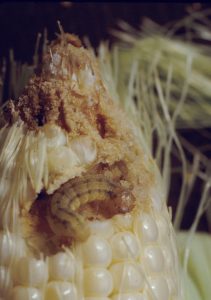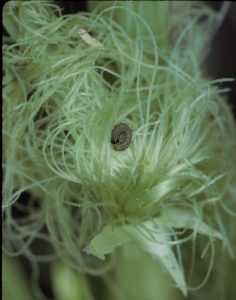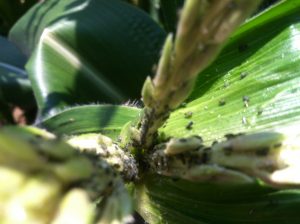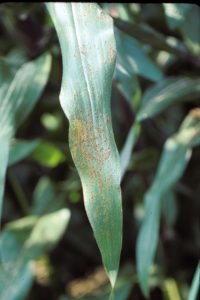Sweet Corn IPM Newsletter No. 7 – August 10, 2018
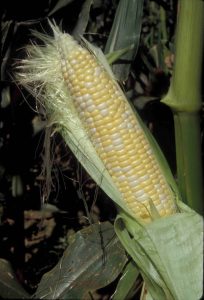 Sweet Corn IPM Newsletter No. 7 – August 10, 2018
Sweet Corn IPM Newsletter No. 7 – August 10, 2018
Click on photos to enlarge.
CORN EARWORM, FALL ARMYWORM THREAT INCREASES
Silking Corn Fields Require Protection
SITUATION
All but the latest planted fields are now silk or beyond. Storm fronts approaching from the south and west have brought up more corn earworm and some fall armyworm to threaten fields with silking corn. Fall armyworm can be troubling at this time, as eggs laid on silking corn allow larvae to move into the ears undetected by field scouting.
European corn borer: Moth activity declined in most locations this week, with the exception of a site in Sabattus. The five moths/week threshold was only exceeded in Sabattus and one Wells site. However, both of these sites were also under a spray interval for corn earworm, which should also protect against corn borer. Feeding damage was very light, with no sites over the 15% spray threshold for pre-tassel to silking corn.
Corn earworm: Numbers of moths caught in traps increased at many sites this week, leading to sprays recommended for nearly all silking fields. A 6-day spray interval for all silking corn was recommended for one site in Wells. A 5-day spray interval was recommended for Bowdoinham, Charleston, one Lewiston site, Palmyra, Sabattus and Wayne. A 4-day spray interval was recommended for silking fields in Biddeford, Cape Elizabeth, Dayton, Levant, and one Wells site.
- Corn Earworm Larvae; photo by David Handley
- Fall Armyworm on Corn Silk; photo by David Handley
Fall armyworm: We have started catching moths in our pheromone traps this week, but these have not yet been widespread. This species has historically been the most challenging to trap, and in some years the traps have performed poorly in terms of predicting the damage we find in the field and ears. This may be the situation this season as we have heard from a grower of ears being infested, despite no captures of moths in our traps. This is why we recommend growers consider applying an insecticide when the corn is in the late pre-tassel to tassel/early silk stage, especially if any moth activity or feeding damage has been observed in the field, because this is often when caterpillars are most exposed, as they move from one part of the plant to another. It is also the time when protection of the emerging silk is most critical to prevent infestation. Furthermore, fall armyworm larvae can be difficult to control despite regular sprays, as they tend to be more resistant to many of the insecticides used in corn than the other species we target. Remember, the larvae also tend to be more exposed at night, making evening sprays more effective. The addition of a spreader-sticker with the insecticide can also help to get the best coverage possible and extend the effective time of the application.
Corn leaf aphids: These insects often infest corn plants later in the season, especially in fields that have not recently been sprayed for other pests. Colonies of bluish-green aphid can cover tassels, stalks and husks. Their waste encourages the dark, slimy sooty mold fungus, which covers the surface of the husks. Sprays for corn earworm will usually control aphids.
- Aphids on Corn Tassel; photo by Kaytlin Woodman
- Rust on Corn; photo by David Handley
Corn rust: Rust is a fungus disease that causes reddish-brown pustules on corn leaves and husks, reducing the quality of the ears. A fungicide spray for rust would only be recommended if the infection were noticed in a field prior to tasseling. Later infections are unlikely to cause enough damage to the crop to justify control measures. Materials available to control corn rust include Quadris®, Bravo®, and Quilt®.
Sincerely,
David T. Handley
Vegetable and Small Fruit Specialist
Highmoor Farm, P.O. Box 179, 52 US Route 202, Monmouth, ME 04259, 207.933.2100
UMaine Extension Diagnostic Research Lab, Pest Management Unit, 17 Godfrey Drive, Orono, ME 04473, 1.800.287.0279
| Location | CEW Moths |
ECB Moths |
FAW Moths |
% Feeding Damage |
Recommendations / Comments |
|---|---|---|---|---|---|
| Biddeford | 14 | 1 | 0 | 1% | 4-day spray interval recommended on all silking corn |
| Bowdoinham | 5 | 0 | 0 | 4% | 5-day spray interval recommended on all silking corn |
| Cape Elizabeth | 65 | 1 | 0 | 0% | 4-day spray interval recommended on all silking corn |
| Charleston | 6 | 0 | 0 | 0% | 5-day spray interval recommended on all silking corn |
| Corinth | 8 | 0 | 2 | 1% | 4-day spray interval recommended on all silking corn |
| Dayton I | 18 | 0 | 0 | 0% | 4-day spray interval recommended on all silking corn |
| Dayton II | 28 | 2 | 0 | 0% | 4-day spray interval recommended on all silking corn |
| Farmington | 0 | 2 | 3 | One spray for FAW on all silking corn | |
| Levant | 14 | 0 | 0 | 1% | 4-day spray interval recommended on all silking corn |
| Lewiston I | 0 | 2 | 18 | 2% | One spray for FAW on all silking corn |
| Lewiston II | 4 | 2 | 0 | 5-day spray interval recommended on all silking corn | |
| New Gloucester | 1 | 0 | 0 | 1% | No spray recommended |
| Oxford | 1 | 0 | 5 | 1% | One spray for FAW on all silking corn |
| Palmyra | 6 | 3 | 0 | 0% | 5-day spray interval recommended on all silking corn |
| Sabattus | 7 | 47 | 5-day spray interval recommended on all silking corn | ||
| Wayne | 7 | 2 | 5 | 10% | 5-day spray interval recommended on all silking corn |
| Wells I | 2 | 0 | 0 | 0% | 6-day spray interval recommended on all silking corn |
| Wells II | 50 | 7 | 0 | 6% | 4-day spray interval recommended on all silking corn |
CEW: Corn earworm (Only fresh silking corn should be sprayed for this insect.)
ECB: European corn borer
FAW: Fall armyworm
| Moths caught per week | Moths caught per night | Spray interval |
|---|---|---|
| 0.0 to 1.4 | 0.0 to 0.2 | No spray |
| 1.5 to 3.5 | 0.3 to 0.5 | Spray every 6 days |
| 3.6 to 7.0 | 0.6 to 1.0 | Spray every 5 days |
| 7.1 to 91 | 1.1 to 13.0 | Spray every 4 days |
| More than 91 | More than 13 | Spray every 3 days |
Thresholds apply only to corn with exposed fresh silk. Lengthen spray intervals by one day if maximum daily temperature is less than 80°F.
European Corn Borer Thresholds
Whorl stage: 30% or more of plants scouted show injury.
Pre-tassel-silk: 15% or more of plants scouted show injury.
Silk: 5 or more moths caught in pheromone traps in one week.
IPM Web Pages:
UMaine Cooperative Extension Integrated Pest Management
UMass Amherst Integrated Pest Management
Where brand names or company names are used, it is for the reader’s information. No endorsement is implied nor is any discrimination intended against other products with similar ingredients. Always consult product labels for rates, application instructions and safety precautions. Users of these products assume all associated risks.
The University of Maine is an equal opportunity/affirmative action institution.

